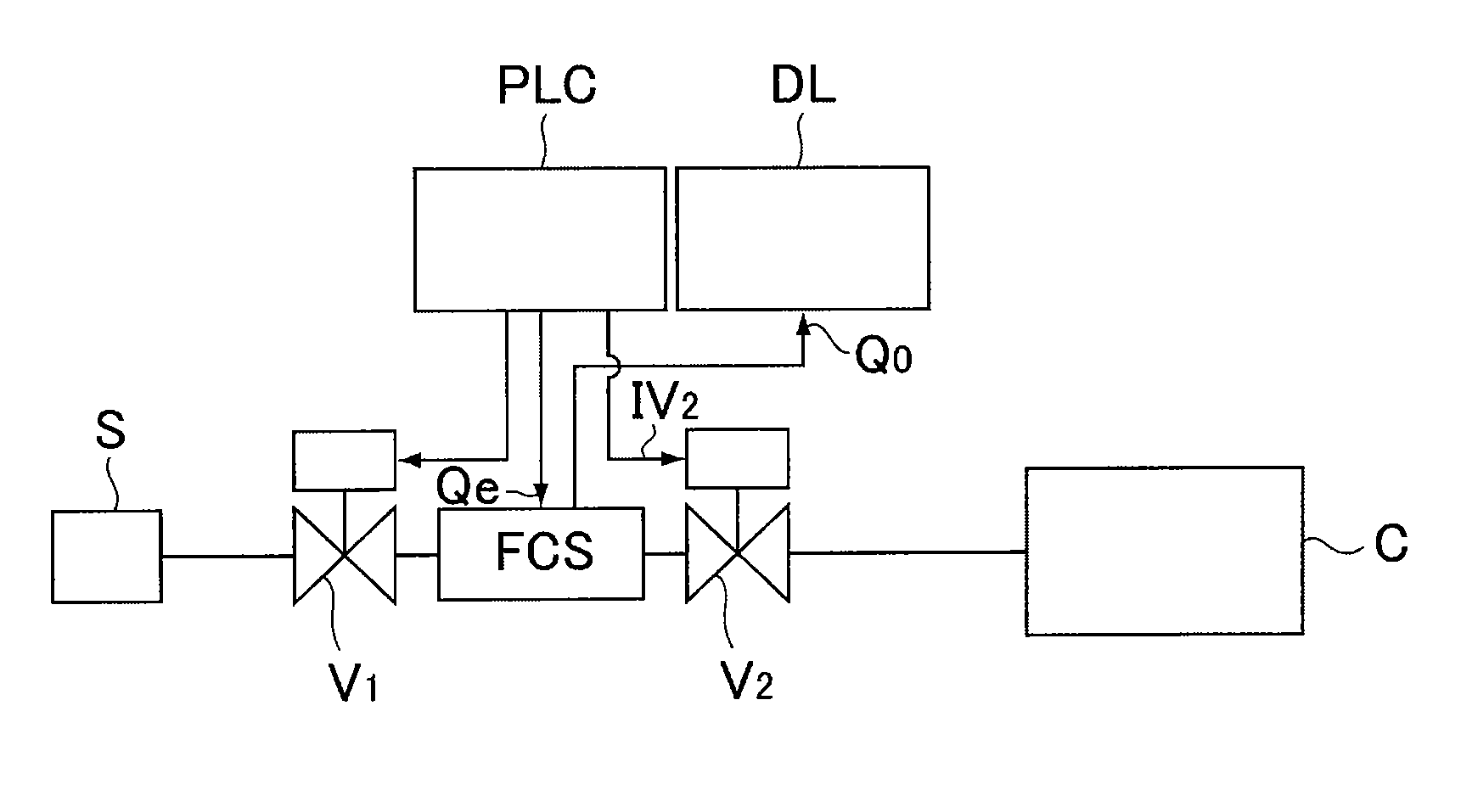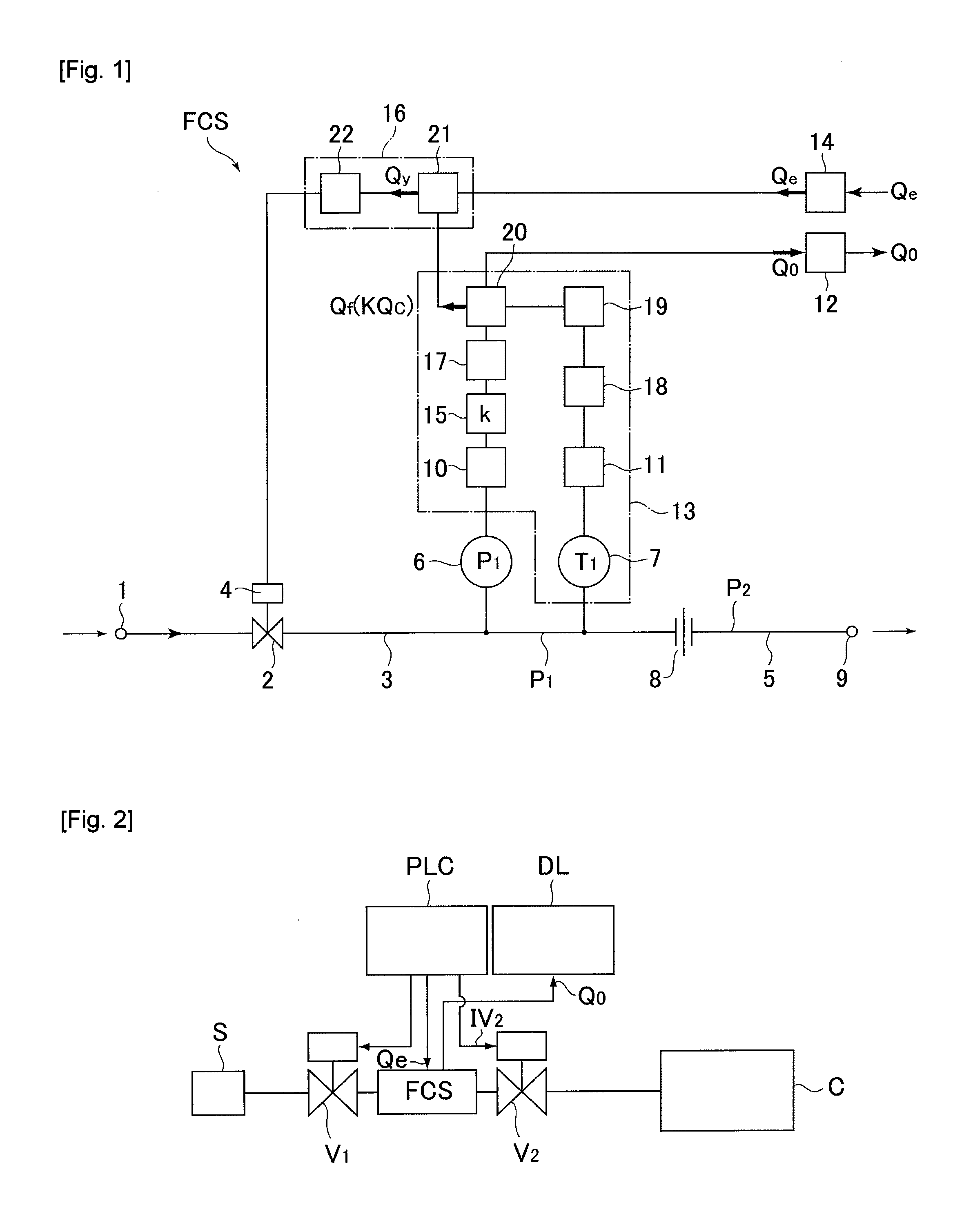Method for detecting malfunction of valve on the downstream side of throttle mechanism of pressure type flow control apparatus
- Summary
- Abstract
- Description
- Claims
- Application Information
AI Technical Summary
Benefits of technology
Problems solved by technology
Method used
Image
Examples
embodiment 1
[0093]FIG. 2 is an explanatory drawing of a test unit used for executing a method for detecting the malfunction of a valve on the downstream side of a throttle mechanism in accordance with Embodiment 1 of the present invention. Namely, as shown in FIG. 2, the test unit is so constituted that a gas supply valve V1 and a valve V2 on the downstream side of the throttle mechanism are connected to the upstream side and downstream side of a pressure type flow control apparatus FCS respectively, thereon a programmable controller PLC and a data logger DL are set, and following the prescribed program from the programmable controller PLC, a flow rate setting signal Qe is supplied to valves V1, V2 and a flow rate setting circuit 14 of a pressure type flow control apparatus FCS, and a valve releasing signal IV2 to a valve V2, a flow rate setting signal Qe to the FCS and a flow rate output signal Qo from the FCS are recorded on the data logger respectively. With FIG. 2, S designates a gas source...
embodiment 2
[0097]Embodiment 2 is made so that an operational malfunction of a valve V2 on the downstream side of a throttle mechanism is detected at the time of the completion of a process treatment. FIG. 4 is an explanatory drawing of a test system used with Embodiment 2. In FIG. 4, EV designates an operational electro-magnetic valve, V1 designates a valve on the FCS upstream side, Pe designates a vacuum pump, Pb designates a Baratron vacuum pump, VR designates a flow rate valve, N2 designates an operational gas, and PG designates a process gas.
[0098]The detection of the operational malfunction of the valve V2 on the downstream side of the throttle mechanism has been performed in a manner such that changes of a FCS flow rate output signal Qo are monitored after a flow rate setting signal Qe to the FCS is set to zero (the FCS shutdown) at the time when a treatment process is terminated, for two distinct cases. In one case, as shown in FIG. 5(a), the shutdown of a flow rate setting signal Qe of...
embodiment 3
[0103]With Embodiment 3, the malfunction of a valve V2 on the downstream side of a throttle mechanism (releasing not functioning) is detected by monitoring a FCS flow rate output signal at the time of a startup of a pressure type flow control apparatus FCS. This is mainly used to detect any operational malfunction of valve V2 on the downstream side of the throttle mechanism during the preparatory stage of starting up a process system.
[0104]A test device used with Embodiment 3 is same as that shown in FIG. 4. Specifically, with Embodiment 3, the malfunction of a releasing operation of a valve V2 on the downstream side of the throttle mechanism is determined by monitoring the drop quantity of a FCS flow rate output signal Qo which occurs within a time Δt (a delay time Δt=0.2 sec) from a valve V1 on the primary side of the pressure type flow control apparatus FCS, and valve V2 on the downstream side of the throttle mechanism is released until a flow rate setting signal Qe being inputte...
PUM
 Login to View More
Login to View More Abstract
Description
Claims
Application Information
 Login to View More
Login to View More - R&D
- Intellectual Property
- Life Sciences
- Materials
- Tech Scout
- Unparalleled Data Quality
- Higher Quality Content
- 60% Fewer Hallucinations
Browse by: Latest US Patents, China's latest patents, Technical Efficacy Thesaurus, Application Domain, Technology Topic, Popular Technical Reports.
© 2025 PatSnap. All rights reserved.Legal|Privacy policy|Modern Slavery Act Transparency Statement|Sitemap|About US| Contact US: help@patsnap.com



